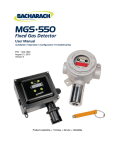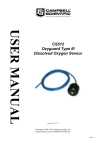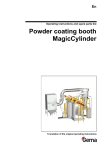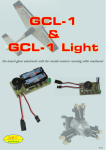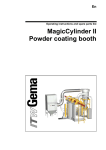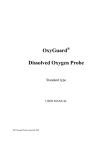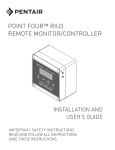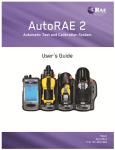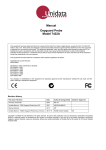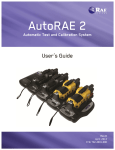Download OxyGuard ® PPB ppb Analyser for Dissolved Oxygen User`s Manual
Transcript
OxyGuard® PPB ppb Analyser for Dissolved Oxygen User's Manual Ser. Nr.: Range: Output: Supply: Div.: Delivery Checked by: L01 PPB manual gb 0201 CONTENTS 1. DESCRIPTION 1.1 General ...........................................................................................................................1 2. INSTALLATION 2.1 General ...........................................................................................................................2 2.2 Transmitter Installation................................................................................................2 2.3 Measurement Chamber Installation ............................................................................3 2.4 Sample Water Connections...........................................................................................3 3. CALIBRATION AND ALARM SET POINT ADJUSTMENT 3.1 Calibration .....................................................................................................................5 3.2 Adjustment of Sample Water Flow..............................................................................6 3.3 Alarm Set Point Adjustment.........................................................................................6 4. SERVICE AND MAINTENANCE 4.1 General ...........................................................................................................................7 4.2 Fault Finding..................................................................................................................7 4.3 Membrane Replacement ...............................................................................................7 4.4 Spare Parts .....................................................................................................................8 5. SPECIFICATIONS and DETAILED DESCRIPTION 5.1 Transmitter ..................................................................................................................10 5.2 Probe .............................................................................................................................11 DIMENSIONAL DRAWINGS 1. DESCRIPTION 1.1 General The OxyGuard ppb analyser is designed to measure dissolved oxygen in feed water, condensate, district heating water or similar. The standard model has a single range, but a dual-range model is also available. The OxyGuard ppb analyser consists of a transmitter unit and a probe with measurement chamber. The transmitter has a display that shows the measured value, a galvanically isolated analogue output and an alarm output. It has a calibration timer which blocks the alarm output and sets the analogue output to its zero value, so that calibration can be performed without triggering alarm. The analyser can either measure a sample flow that is led to a drain or measure on a by-pass loop at up to 6 bar pressure. When used with the outlet to drain the measurement chamber is fitted with a check valve to retain water in it at all times. If there are two ranges, range selection is made by a " HI - LO" range selector switch on the front panel. Please read ALL this manual before using the instrument. The probe is shipped in a transport chamber that contains water with little or no oxygen, and the probe should not be removed until all parts are installed and the probe is to be calibrated. SPECIAL FEATURES It is important to note that the OxyGuard PPB analyser has a number of features that make its use and maintenance significantly different from that of other analysers for low level dissolved oxygen. If you are familiar with other analysers you must be aware that the OxyGuard PPB analyser NEEDS MUCH LESS CARE AND ATTENTION THAN OTHER SUCH ANALYSERS. If the probe should ever need attention, i.e. if the membrane should suffer damage, the necessary service can be performed by anyone on the basis of the spares shipped with the unit and the instructions in this manual. Special training is NOT needed. It is important to note that the probe functions best if you do NOT take it apart for maintenance! THE OXYGUARD PPB ANALYSER IS A SENSITIVE INSTRUMENT. PLEASE FOLLOW THE INSTRUCTIONS IN THIS MANUAL CAREFULLY. SPECIAL FEATURES FAST RESPONSE HIGH STABILITY NO REGULAR SERVICE NEEDS NOT SENSITIVE TO SAMPLE FLOW RATE EASY TO CALIBRATE FAST RETURN TO LOW PPB MEASUREMENT AFTER CALIBRATION FAST AND EASY MEMBRANE REPLACEMENT NO SPECIAL TRAINING NEEDED NOT CROSS-SENSITIVE TO HYDROGEN 1 2. INSTALLATION NB IMPORTANT: DO NOT REMOVE THE PROBE FROM THE TRANSPORT CHAMBER UNTIL IMMEDIATELY BEFORE INITIAL CALIBRATION. THE PROBE IS BEST STORED IN LOW-OXYGEN WATER THE FOLLOWING INSTALLATION PROCEDURE MUST BE CARRIED OUT IN THE STATED ORDER THOROUGHLY FLUSH SAMPLE WATER PIPES BEFORE CONNECTION TO THE MEASUREMENT CHAMBER 2.1 General When planning installation please take any steps possible to ensure a stable, accurate measurement. Both the surroundings and sample should have a constant, moderate temperature. Do not subject the equipment to vibration or radiant heat. Oxygen diffuses through plastics, rubber etc. Use metal pipes with welded, brazed or metal joints for the sample water. The flexible aluminium tubing supplied with the equipment is ideal. Even though the system is not sensitive to electrical noise it should, as a matter of principle, NOT be placed near sources of electrical noise. 2.2 Transmitter Installation NB.: MAKE SURE THAT THERE IS ENOUGH ROOM TO THE SIDES OF THE CABINET TO RELEASE THE RIGHT-SIDE LOCK WITH A LARGE SCREWDRIVER AND TO SWING THE TOP HALF OPEN. Mount the cabinet using the holes in the corners. Connect as indicated below. Do not coil up, stretch or sharply bend the probe cable. Place the probe cable so that the probe can easily be hung up for calibration. Connect the probe - still in the transport chamber - and switch the transmitter on. Please note that it can take 5 minutes for the equipment to warm up and stabilize. 2.2.1 Electrical Connections 1 230 V 2 3 0 V earth Mains Supply 4 5 6 7 8 NC C NO + - Alarm relay 9 yellow Analogue Output green 3 2 1 4 brown grey The pin numbers run clockwise, starting at the index notch, when looking at the socket on the transmitter unit (from the outside). 2 11 12 13 brown NC yellow green grey NB The probe connections are effected via a factory-wired connector. The internal connections of the plug are as follows: Probe connector (transmitter socket) and cable colours 10 To Probe NB. It may in some cases be practical to shorten the cable. The procedure is quite easy, but the proper tools must be used To keep the EMC protection the probe cable must be without joins and terminated properly. 2.3 Measurement Chamber Installation The chamber has 6 mm pipe fittings and is supplied mounted on a plastic plate, with two holes for easy fixing - see the drawing at the end of the manual. The inlet is normally to the left, the outlet to the right, but the chamber can be supplied with the opposite flow direction. The sample piping must be thoroughly flushed clean before you connect it. The measurement chamber is often fed with a sample flow that is led to a drain afterwards. The check valve in the inlet means that you can turn the flow off or even disconnect the inlet for long periods and still retain low oxygen water from the last sample in the chamber so that the probe does not need to be removed during operation standstills. NB Use two spanners to tighten fittings or you may shatter the measurement chamber. NB. The probe is not crosssensitive to hydrogen. The unit can also measure in a by-pass loop at up to 6 bar pressure, eg. on stator cooling water. In this case the insert must be removed from the check valve. Make sure that the piping system generates sufficient pressure drop to ensure a flow of at least 100 ml/min through the chamber. 2.4 Sample Water Connections All sample water connections should be made in metal tubing such as the aluminium tubing supplied, with connections either welded, brazed or carefully made using metal compression ring fittings. The sample should preferably be cooled to room temperature, since this makes calibration even easier. The sample temperature should be kept as constant as possible. Flush all sample piping thoroughly and check that it can deliver at least 100 ml/min at a suitable steady temperature. Connect the piping to the measurement chamber and prepare for calibration. WHEN THE ABOVE HAS BEEN PERFORMED YOU SHOULD MAKE PREPARATIONS FOR CALIBRATION, THEN REMOVE THE PROBE FROM THE TRANSPORT CHAMBER, CALIBRATE IT AND PLACE IT IN THE MEASUREMENT CHAMBER AS DESCRIBED IN THE FOLLOWING. 3 NB A flow of 100 ml/min is sufficient. The equipment will easily measure at larger flow rates, but larger flow rates constitute a waste of water. . System configuration, atmospheric pressure measurement AMPLIFIER DO NOT KINK THE LEAD LEAVE ENOUGH LEAD TO LIFT PROBE FOR CALIBRATION AND CLEANING ETC. W xD xH: 190 x 96 x 240 mm 4 mounting holes, centres 161 x 220 mm PROBE SAMPLE COOLER DO NOT LET PIPING STRESS THE MEASUREMENT CHAMBER ALARM AND ANALOGUE OUTPUTS TO MAINS SUPPLY CHECK VALVE TO DRAIN FLOW DIRECTION NB. USE METAL PIPE AND FITTINGS 1 2 2 1 TIGHTEN WITH TWO SPANNERS System configuration, measurement under pressure (max. 6 bar) AMPLIFIER 1) DO NOT KINK THE LEAD. LEAVE ENOUGH LEAD TO LIFT PROBE FOR CALIBRATION AND CLEANING ETC. W xD xH: 190 x 96 x 240 mm 4 mounting holes, centres 161 x 220 mm PROBE SAMPLE COOLER ALARM AND TO MAINS ANALOGUE SUPPLY OUTPUTS 2) WHEN MEASURING UNDER PRESSURE ON CLOSED SYSTEMS (EG. STATOR COOLING WATER) REMOVE THE INSERT FROM THE CHECK VALVE BODY AND ENSURE THAT THERE IS ENOUGH PRESSURE DIFFERENCE TO MAINTAIN FLOW THROUGH THE MEASUREMENT CHAMBER. CHECK VALVE NB. USE METAL PIPE AND FITTINGS FLOW DIRECTION 1 2 2 1 TIGHTEN WITH TWO SPANNERS 4 3) DO NOT LET PIPING STRESS THE MEASUREMENT CHAMBER 3. CALIBRATION AND ALARM SET POINT ADJUSTMENT 3.1 Calibration Calibration once every three months is often sufficient. Calibration is an easy process that can usually be performed in less than two minutes. It is advisable to make all preparations before removing the probe from the low-oxygen content water. It is important to note that the longer the probe is in air during calibration, the longer it will take for it to return to its working point in very low oxygen content water. The probe MUST have the same temperature as the air when it is calibrated. If you adjust the sample water temperature to that of the air, or place the probe in a beaker of low-oxygen-content water at air temperature some minutes before taking the probe up for calibration you will not have to wait a long time for temperature equalization. The probe will not suffer by being in the air for a day or two, but it may take some time before it again measures accurately at a few PPB. Temperature equalization has taken place when the reading is steady. For the greatest accuracy check the barometric pressure and find the calibration value from the table. Otherwise calibrate to 100. Prepare to remove the probe from the chamber. Clean its outside if necessary. Note that the analogue output automatically goes to 4 mA (the 0 ppb value) when the calibration timer is running. Barometric Pressure Calibration Value mmHg mBar 730 973 740 986 750 1000 760 1013 770 1026 780 1040 790 1053 96 97 99 100 101 103 104 You can now proceed as follows: a) Press "Cal Init" to start the timer - see that the yellow lamp is lit. b) Unscrew the ring and lift the probe from the chamber. If it was in the transport chamber, or measured a liquid other than clean water, rinse it thoroughly in clean water. Carefully dry the membrane with a cloth or soft paper. Hang the probe in free air, away from sources of direct heat. The 7 minute calibration timer blocks the alarm function, sets the analogue output to 4 mA (the 0 ppb value) and changes the amplification of the system so that you always calibrate to "100" or corresponding corrected value. c) Observe the display When the display reading is stable, which usually takes about one minute, adjust the "CAL" front panel trimmer until the display shows the calibration value. d) Place the probe into the chamber - filled with water. NOTE THE PLACING OF THE GASKET between the flange and chamber top. e) Ensure that the seal seats correctly and that air bubbles are not trapped in the chamber. Tighten the ring. If any bubbles are trapped turn the flow off for a few seconds - the bubbles will rise to the top of the chamber and be flushed out when the flow is turned on again. f) Check that the sample flow is approximately 100 ml/min. 5 NB.! gasket A stable measurement should be attained after a few minutes, depending on the oxygen concentration in the sample and the length of time it took to calibrate. If calibration took a long time and you can see that the measurement value will cause alarm when the timer runs out you can press "Cal Init" twice to start another 7 minute period. Calibration is now complete. 3.2 Adjustment of sample water flow If necessary the sample water flow can be adjusted AFTER CALIBRATION: If there is a limited supply of water the flow can be gradually reduced until the measured value begins to fall, then increased to just over this value. If the reading falls when the flow is increased, air is entering the sample line. Locate the leak and repair it. 3.3 Alarm Set Point Adjustment Push and hold the small black button under the "Alarm Set" control. Adjust "Alarm Set" until the display shows desired value. For single range models the display shows the alarm setting in ppb directly, but in dual-range models the meaning of display reading when setting the alarm limit depends on whether “HI” or “LO” is selected: I:E: WHEN “ALARM SET” is held depressed: If “LO” is selected a display of 200 means a set point of 20.0 ppb If “HI” is selected a display of 200 means a set point of 200 ppb. Zero Check Zero check is not necessary, but if you suspect that the zero has drifted a little please contact your supplier or OxyGuard International A/S. NB. NEVER PLACE THE PROBE IN CONCENTRATED SODIUM SULPHITE SOLUTION 6 When the sample line (and cooler, if used) are correctly established the measurement will be constant over a very large flow range. 4. SERVICE AND MAINTENANCE 4.1 General There is no need for regular maintenance or service, just keep the probe membrane free from deposits. The membrane can be wiped clean with a cloth or soft paper. Do not try to scratch it clean with a fingernail! Remember to press "Cal Init" before removing it from the chamber. All necessary spares etc. are shipped with the unit. THERE IS NO NEED TO CHANGE THE ELECTROLYTE REGULARLY! The probe should not be taken apart unless the membrane is damaged, e.g. due to accident when cleaning it. 4.2 Fault Finding REMEMBER TO SWITCH OFF THE SUPPLY TO THE UNIT AND TO CIRCUITS CONNECTED TO THE ALARM OUTPUT BEFORE REMOVING THE FRONT PANEL OR TERMINAL COVER - A HAZARD EXISTS IF THIS IS NOT DONE! 4.2.1 If the system is completely "dead" first change the fuse (160 mA slow-blow). If this does not help, consult your dealer. 4.2.2 A sudden fault - e.g. with a zero or negative display - can be caused by a damaged or faulty cable or connections. 4.2.3 An unstable display can also be caused by a damaged membrane - check it and replace if necessary. 4.2.4 If the probe seems to be sensitive to small changes in flow, air (oxygen) is entering the piping or measurement chamber. Inspect/renovate the piping and chamber, check all joints. 4.3 Membrane Replacement THIS SHOULD ONLY BE PERFORMED IF THE MEMBRANE IS DAMAGED. Switch off the unit. Unplug and remove the probe. Carefully unscrew the cap and discard the electrolyte. The anode should be clean. If there are deposits on the cathode it can be carefully cleaned in water or under the tap using grade 1000 emery paper. The cathode must NOT be polished. A new membrane must be fitted to the cap. Unscrew the retaining ring in the bottom of the cap using the special tool provided. Discard the membrane and the O-ring. The cap and retaining ring should be rinsed and dried thoroughly. Place a new O-ring in the bottom of the cap and a new membrane on top of the O-ring. Screw the retaining ring tightly into place. The membrane must remain flat. If it wrinkles remove it and try again with a new membrane and O-ring. It is important that all parts are completely clean and dry. 7 See the drawings! Rinse the probe in demineralised water. Fill the cap to the brim with fresh electrolyte. Hold the probe vertically, move the cap up to the probe and gently screw it in place without turning it back at any time. Surplus electrolyte should trickle from the screw thread. It is important that the probe is completely filled and that the cap is screwed firmly in place. The probe can now be regarded as new. It can, however, take a few hours before it reaches its correct working point and stability. It should therefore be calibrated, mounted back in the measurement chamber and used for two days before being re-calibrated. 4.4 Spare Parts The OxyGuard ppb oxygen analyser system is manufactured from tried and tested parts of the highest quality, so the need for spare parts is minimal. The parts delivered with the unit should cover the need for spares for 20 years use, otherwise spares can be obtained from OxyGuard. 8 PPB - Membrane Replacement Probe Body 3) Discard used membrane and O-ring Cap 2) Discard electrolyte 1) Unscrew cap 7) Fit retaining ring 6) Place new membrane 5) Place new o-ring 8) Fill with electrolyte 4) Wash and thoroughly dry cap and retainer ring 9 9) Assemble, tighten cap firmly by hand 5. SPECIFICATIONS and DETAILED DESCRIPTION 5.1 Transmitter Construction: Rilsan coated aluminium alloy enclosure with LCD display, calibration and alarm set point adjustment, terminals, power supply, electronics and alarm relay. Dimensions: b x d x h: 190 x 240 x 100 mm Weight: approx. 3 kg. Supply: 230 VAC. Other on request. Operating temperature: -5°C to 60°C Encapsulation: IP 65 Input: Voltage signal from the probe. The input is galvanically isolated from the output. Analogue Output: 0-20 mA or 4-20 mA (as ordered). Max. loop impedance 700 ohm. For 2 range model 20 mA = the full scale selected by range select switch. E.G. 20 mA = 100 ppb if "LO" selected and 1000 ppb if "HI" selected. Standard Range: 0-100 ppb. 2-range version “LO” = 100 ppb and “HI” = 1000 ppb. Alarm output: 1 high alarm. Potential free change over switch, max. 200 VA relay activates on rising or falling signal, as ordered. System Accuracy: +/- 1 ppb when measuring temperature = calibration temperature. Saturation Curve: DIN 38404, part 22 (1986). The transmitter consists of a cast metal enclosure with front panel assembly and a main circuit board. The front panel assembly comprises the display, an alarm set control, calibration trimmer, pushbuttons for alarm value display and calibration timer activation and indicator for calibration timer. The main circuit board has terminals, alarm relay, power supply and input and output circuits. The input is the microvolt signal from the probe. The single range model has as standard a measurement range of 0-100 microgram per liter (ppb), the dual range 0-100 and 0-1000 microgram per litre selected using a small ALO-HI@ switch. The display can over-range to 170 or 1700, but the analogue output is limited to 20 mA. In the dual-range model the analogue output changes to correspond to the selected range. The analogue output in OxyGuard ppb analyser is galvanically isolated from the input and can be factory set to either 0-20 mA or 420 mA, max load 700 ohms (4-20 mA is standard). The alarm relay is usually coded to activate when the measured value rises above the alarm value. The alarm set point value is shown on the display when the small black pushbutton under the "Alarm Set" control is held depressed. The calibration timer, which runs for 7 minutes, is started and stopped by pressing the "Cal Init" button. The yellow indicator lights when the timer is running, during which time the alarm function is blocked, the analogue output is set to the zero value and the amplification of the system is changed to enable calibration. 10 Please note that the contact output is a potential free (dry) change over contact, max. load 200 VA at 230 VAC. 5.2 Probe Probe dimensions: Type: Sample temperature: Temperature compensation: Measurement Chamber: Sample flow: Sample pressure: Response Time: 21.5 mm diameter x 135 mm with 3 m special cable. Self polarizing (galvanic) membrane covered amperometric cell 5°C to 50(C Automatic. Clear acrylic chamber with 6 mm compression ring fittings and valve. Depends on oxygen content and temperature - min. 100 ml/min, max. 2000 l/min. up to max. 6 bar. Less than 20 sec for 90% of a step change. From 1 minute in air (calibration) to 100 ppb in approximately 40 sec, and to 10 ppb in less than 3 minutes. The probe is a galvanic measuring element which generates a microvolt output proportional to the dissolved oxygen. It is manufactured in stainless steel and consists of an upper part with cathode, anode and cable, and a cap with membrane and electrolyte. The cable between the probe and the transmitter unit is a special screened 3 metre long cable with connector. The cable and connector are EMC optimized to give the best possible noise protection. The probe can be ordered with longer cable. Oxygen diffuses through the membrane onto the cathode, where it reacts chemically and then combines with the anode. This chemical process develops an electrical current, which is converted into a voltage (of approximately 50 μV at 10 ppb) via a linearization resistor. The measurement chamber has 6 mm compression ring fittings and check valve in the inlet, all mounted on a plastic plate, ready for fixing with two 6 mm screws - see the drawing at the end of this manual. The check valve ensures that when measuring at atmospheric pressure water from the last sample remains in the chamber - i.e. it remains filled with water even if the feed is turned off. IMPORTANT When the measurement is made on a bypass under pressure (e.g. on stator cooling water) the check valve insert must be removed. The probe is not cross-sensitive to hydrogen. N.B. The system has EMC (CE) approval Standard Accessories 2 m flexible sample tubing O-rings User Manual Membranes Electrolyte Special tool The equipment is supplied ready for use Data subject to change without notice 11 Transmitter Unit 96 90 150 190 Mounting hole centers 161 x 220 mm 35 40 40 40 approx. 150 All dimensions in millimeter 27,5 7 55 2 holes, 6 mm dia. 76 90 approx.. 128 12 Measurement Chamber with Probe














